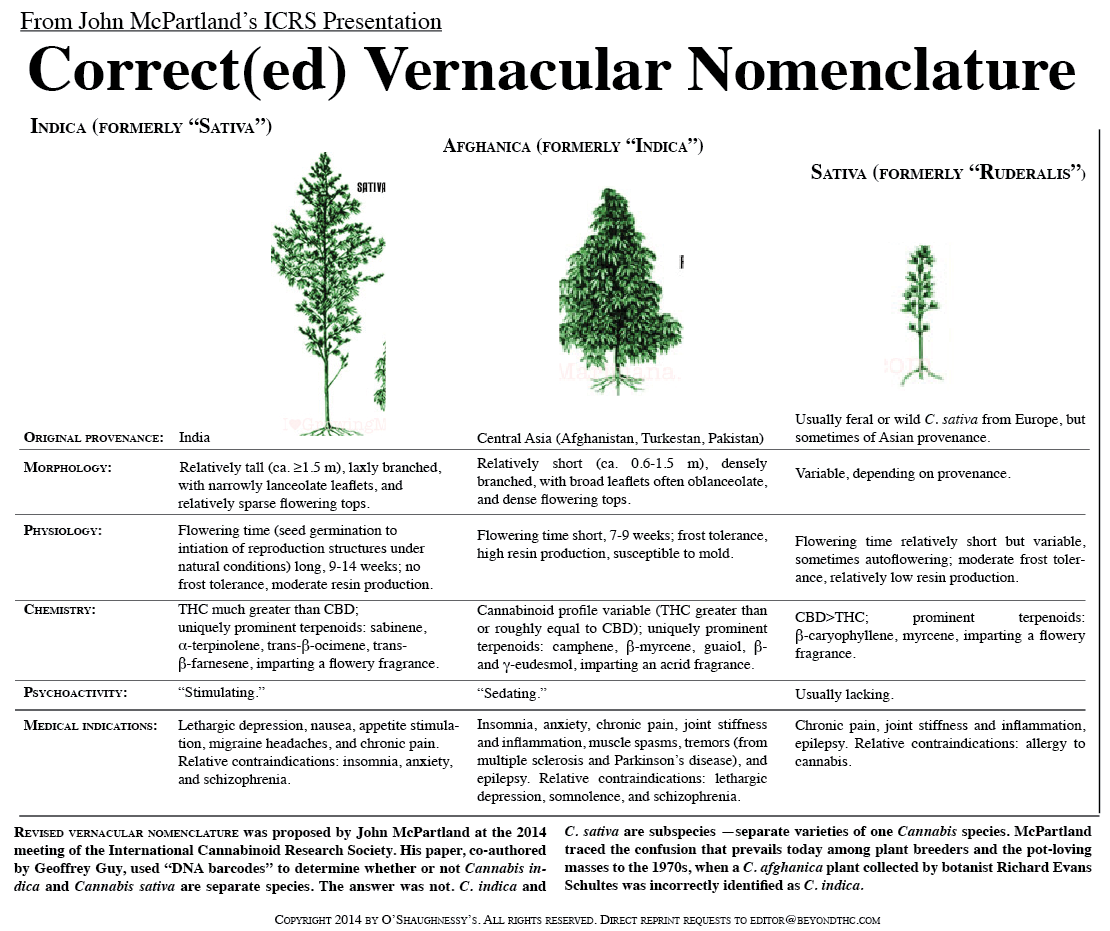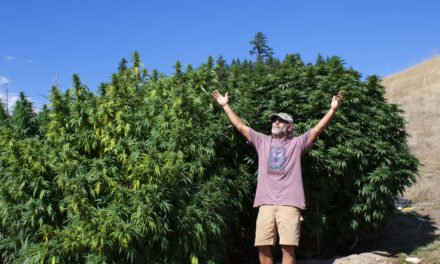January 4, 2015 By O’S News Service
An ambitious call to standardize the names used by non-scientists in reference to Cannabis plants —to create an accurate vernacular nomenclature— was made by Dr. John McPartland at the 2014 meeting of the International Cannabinoid Research Society and will be published in O’Shaughnessy’s upcoming print edition. McPartland’s ICRS paper, co-authored by Dr. Geoffrey Guy, used “DNA barcodes” to determine whether or not Cannabis indica and Cannabis sativa are separate species. The answer was not. C. indica and C. sativa are subspecies —separate varieties of one Cannabis species.
McPartland traced the confusion that prevails today among plant breeders and the pot-loving masses to the 1970s, when a C. afghanica plant collected by botanist Richard Evans Schultes was incorrectly identified as C. indica.
Biologist Ryan Lee saw our graphic summarizing McPartland’s overview and sent him the following inquiry:
When I saw the diagram in the pre-publication layout, I questioned the reclassification of ‘ruderalis’ as ‘sativa,’ and after going over some of the work by Ernest Small, I thought it wise to contact you directly about it before offering my own input/perspective.
Is it correct that you are proposing a renaming of ‘ruderalis’ as ‘sativa’? “Sativa,” derived from the feminine form of the Latin word indicating “cultivated,” in my mind is more appropriately referencing the cultivated forms of NLH (Narrow Leaf Hemp), which I consider a domesticated and selected form of the wild relative. The tall habit of ‘sativa’ or NLH, to me shows selection by humans, presumably for the length of the fiber, and fertilization, which implies a domesticated form, thus ‘sativa’ being a different varietal selection of ‘ruderalis.’
‘Ruderalis’, clearly derives from the word “ruderal,” indicating growing on an area of refuse or waste disturbed by human activity. This seems to fit what Vavilov presented as ‘spontanea,‘ forms of which I’ve seen growing in Austria and elsewhere. I’m having difficulty making the leap from ‘ruderalis’ to ‘sativa,’ as the habit and phenotype of NLH and ‘spontanea’ are remarkably different under cultivation. I don’t have the O’Shaughnessy’s diagram in front of me, so please excuse me if I have mis-interpreted your presentation.
John McPartland replied:
Clarification: I propose reclassifing the VERNACULAR use of “ruderalis” as “sativa” (always in quotation marks). That’s because all the photos of “ruderalis” by cannabis breeders, beginning with Nevil Schoenmaker’s 1986 edition of the Seed Bank, illustrate sativa that has escaped from cultivation —not true wild-type plants. Schoenmaker’s plant shows a robust morphology, apical dominance, and determinate flowering. These traits are consistent with C. sativa, a spontaneous escape of cultivated fiber hemp. These traits are not consistent with Vavilov’s or Janischevsky’s concepts of wild-type plants.
Ernest Small published papers on wild-type Cannabis between 1972 and 2003. He adds precision to the notoriously ambiguous terminology that describes wild-weedy-cultivated plants:
· Wild plants are well-and-truly native, indigenous, aboriginal plants—plants that have never been domesticated. Wild plants include the progenitors (i.e., the precursors or ancestors) of domesticated crop plants. Small doubts if such plants still exist.
· Feral plants (i.e., weedy plants, feral hemp) are naturalized plants that escaped human cultivation. They may be ruderal, spontaneous, or volunteers.
· Ruderal hemp (Latin: ruderalis) ambiguously refers to either wild or weedy plants. They grow beyond areas of human habitation.
· Spontaneous hemp (Latin: spontanea) denotes plants that appear locally as a result of human activities, but do not spread—they too can be wild or weedy plants.
· Cultivated plants are domesticated crops. They include volunteer plants—weedy plants arising from crops planted the previous year, or arising around the edges of cultivated fields.
Did you really see C. sativa var. ruderalis growing in Austria? To me, true wild-type plants have a unique seed morphology. Ernest Small: small size, a protuberant, tapered base with a prominent abscission layer, rapid disarticulation from the plant, and a persistent and camouflage-colored perianth. The distinctive protuberant base has been given various names—a “horseshoe,” circular torus, callus-ring, caruncle, basal constricted zone, and elaiosome.
Small makes a discouraging observation that I agree with: He estimated that plants that escaped from cultivation in Canada reverted to a wild-type phenotype within 50 generations (years) of prohibition in North America. Thus the wild-type phenotype cannot distinguish between true wild-type plants and domesticated plants abandoned by humans for a while. We need genetics.
Tangentially: Ernest Small recognizes Vavilov’s spontanea taxon rather than Janischevsky’s ruderalis taxon for wild-type plants. That’s a debate for another day.






